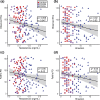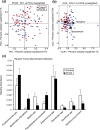Gut Microbial Diversity in Women With Polycystic Ovary Syndrome Correlates With Hyperandrogenism
- PMID: 29370410
- PMCID: PMC6276580
- DOI: 10.1210/jc.2017-02153
Gut Microbial Diversity in Women With Polycystic Ovary Syndrome Correlates With Hyperandrogenism
Abstract
Context: A majority of women with polycystic ovary syndrome (PCOS) have metabolic abnormalities that result in an increased risk of developing type 2 diabetes and heart disease. Correlative studies have shown an association between changes in the gut microbiome and metabolic disorders. Two recent studies reported a decrease in α diversity of the gut microbiome in women with PCOS compared with healthy women.
Objective: We investigated whether changes in the gut microbiome correlated with specific clinical parameters in women with PCOS compared with healthy women. We also investigated whether there were changes in the gut microbiome in women with polycystic ovarian morphology (PCOM) who lacked the other diagnostic criteria of PCOS.
Participants: Subjects were recruited at the Poznan University of Medical Sciences. Fecal microbial diversity profiles of healthy women (n = 48), women with PCOM (n = 42), and women diagnosed with PCOS using the Rotterdam criteria (n = 73) were analyzed using 16S ribosomal RNA gene sequencing.
Results: Lower α diversity was observed in women with PCOS compared with healthy women. Women with PCOM had a change in α diversity that was intermediate between that of the other two groups. Regression analyses showed that hyperandrogenism, total testosterone, and hirsutism were negatively correlated with α diversity. Permutational multivariate analysis of variance in UniFrac distances showed that hyperandrogenism was also correlated with β diversity. A random forest identified bacteria that discriminated between healthy women and women with PCOS.
Conclusion: These results suggest that hyperandrogenism may play a critical role in altering the gut microbiome in women with PCOS.
Figures



References
-
- Fauser BC, Tarlatzis BC, Rebar RW, Legro RS, Balen AH, Lobo R, Carmina E, Chang J, Yildiz BO, Laven JS, Boivin J, Petraglia F, Wijeyeratne CN, Norman RJ, Dunaif A, Franks S, Wild RA, Dumesic D, Barnhart K. Consensus on women’s health aspects of polycystic ovary syndrome (PCOS): the Amsterdam ESHRE/ASRM-Sponsored 3rd PCOS Consensus Workshop Group. Fertil Steril 2012;97(1):28–38.e25. - PubMed
-
- Mykhalchenko K, Lizneva D, Trofimova T, Walker W, Suturina L, Diamond MP, Azziz R. Genetics of polycystic ovary syndrome. Expert Rev Mol Diagn. 2017;17(7):723–733. - PubMed
-
- Azziz R, Carmina E, Chen Z, Dunaif A, Laven JSE, Legro RS, Lizneva D, Natterson-Horowtiz B, Teede HJ, Yildiz BO. Polycystic ovary syndrome. Nat Rev Dis Primers. 2016;2:16057. - PubMed
-
- Goodman NF, Cobin RH, Futterweit W, Glueck JS, Legro RS, Carmina E; American Association of Clinical Endocrinologists (AACE), American College of Endocrinology (ACE), Androgen Excess and PCOS Society . American Association of Clinical Endocrinologists, American College of Endocrinology, and Androgen Excess and PCOS Society disease state clinical review: guide to the best practices in the evaluation and treatment of polycystic ovary syndrome - part 2. Endocr Pract. 2015;21(12):1415–1426. - PubMed
Publication types
MeSH terms
Substances
Grants and funding
LinkOut - more resources
Full Text Sources
Other Literature Sources
Medical

